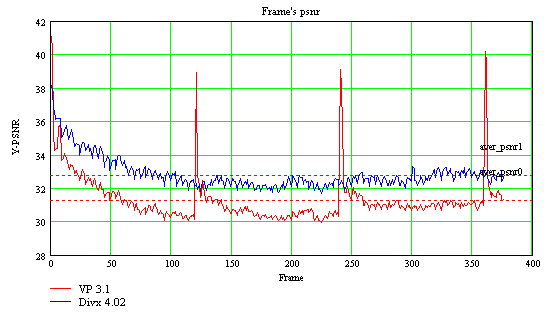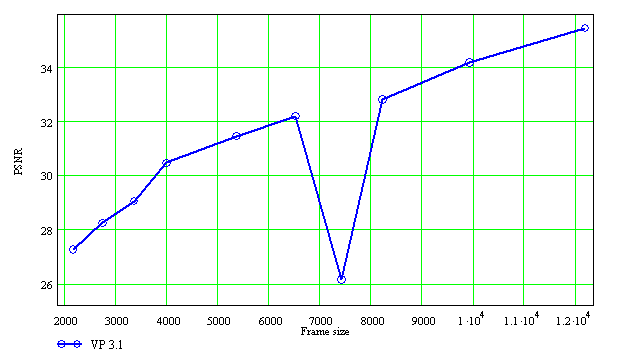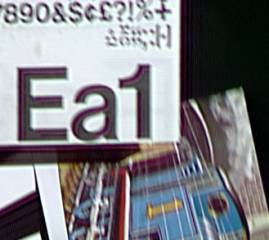Introduction to Video Codecs Comparison
Short introduction
There a lot of different codec comparisons it the internet - long and short, emotional or not, biased and unprejudiced. But most of the authors of such comparisons just put two frames from 2 movies nearby, forgetting following important issues:
1. Every codec gives different quality on different frames of same sequence
Different factors play a role here. First of all, all codecs have bitrate control mechanism that produces quality fluctuations even in very good implementation. Secondly, user selects bitrate control strategy, and in CBR case on slow scenes quality will be low, and on fast ones it will degrade. Thirdly, codecs have a so-called key frame, whose quality is determined separately and differs from other frames. Fourthly quality depends on prefiltrations, that is included on all present-day codecs. That means that on every sufficiently long movie, taking in account that average movie is about 150000-200000 frames, it is possible to select very good and very bad frames, especially if one-pass CBR compression was used, and movie had enough motion. So, if you have one long movie, codec A and B , approximately equal in quality, and normal means of comparison automation (or if you like one of the codecs very much), then it’s easy for you to get a documental prove that codec A s better than B (“just look at those frames!”) and codec B s better than A (“just look at those frames!”). That method is widely used, alike in press-releases and video processing sites.
 Diagram brings into accord with metrics PSNR (if higher, then better quality). If you make a comparison on "peak" frames, the VP result will be better then DivX one. Other frames show the opposite conclusion. |
2. Different codecs are tuned to different film types.
It is known that some time ago simultaneously existed two different codecs - DivX 4.1 LowMotion and DivX 4.1 FastMotion. Playback was same, but their internal parameters were tuned to low and high motion, and compression produced different results. Note - FORMAT was same in both cases, but compression was different, so equal size movies had different quality. Similar devotion to specific data type exists in all codecs. Some codecs better perform on high bitrates , some better compress low ones. Some are tuned to high motion, and some better do with low. Codecs can be tuned to better compress animation or real video. Noisy and clear movies require separate tuning also. That means, that if you have almost equal codecs A and B, it is easy to find movies where A is better than B and vise versa. Curiously this could be same movie, but one could be taken from DVD and other re-filmed in cinema.
|
|
|
|
This is frames quality in conventional colors (black - no difference with original, blue and green - more difference, red - huge difference). If we will use this frames for comparison - DivX 3.1 will be better DivX 5.1.
3. Compression quality could seriously depend on coding parameters.
Most of the people do not think about it (codec author should think about everything), but codecs have many parameters, that sometimes can seriously affect quality (for the same file size). First of all, these are bitrate strategy parameters, especially selection between “quality-based” and “bitrate-based” modes. After that prefiltration parameters play a role. For example, deinterlacing (because some movies were compressed with MPEG4 in interlaced mode), denoising (noise reduction), deflicking (removal of effect) and so on. There are parameters of key frame frequence, B-frame mask, control of prefiltering dependence from movie. etc. That means that if you have A and B codecs of approximately equal quality, you can switch one codec’s mode to maximum performance, and second codec mode to maximum quality and receive two movies of equal size, but unequal quality. One can even put both movies on his site so everyone could see the difference (like some companies do) :-). In that case fact that one codec worked 10 times slower than another somehow becomes lost - why the people (and journalist) should to know such uninteresting information? In that case source sequence could not be found (due o size, for sure), and coding parameters are unknown (and now you know why). Really there are many more delicate ways to receive “advantage” and even real advantage - for example there are no criteria to determine how frame skipping is significant for perception. But these methods are most common. So, if you study “fooling” methods, you could see that sufficiently large testing is required for correct comparison. As a minimum it is important to compare sequences with different characteristic on different bitrates, while using integral (average) quality characteristics throughout the sequence. So, let us wish you successful detailed comparison.

Quality fall in one of the bitrate in this codec, because it has error in rate control.
This is bitrate unlucky for this codec.
Good luck!
Contacts
E-mail: video@graphics.cs.msu.ru
-
MSU Benchmark Collection
- Video Colorization Benchmark
- Video Saliency Prediction Benchmark
- LEHA-CVQAD Video Quality Metrics Benchmark
- Learning-Based Image Compression Benchmark
- Super-Resolution for Video Compression Benchmark
- Defenses for Image Quality Metrics Benchmark
- Super-Resolution Quality Metrics Benchmark
- Deinterlacer Benchmark
- Metrics Robustness Benchmark
- Video Upscalers Benchmark
- Video Deblurring Benchmark
- Video Frame Interpolation Benchmark
- HDR Video Reconstruction Benchmark
- No-Reference Video Quality Metrics Benchmark
- Full-Reference Video Quality Metrics Benchmark
- Video Alignment and Retrieval Benchmark
- Mobile Video Codecs Benchmark
- Video Super-Resolution Benchmark
- Shot Boundary Detection Benchmark
- The VideoMatting Project
- Video Completion
- Codecs Comparisons & Optimization
- VQMT
- MSU Datasets Collection
- Metrics Research
- Video Quality Measurement Tool 3D
- Video Filters
- Other Projects



